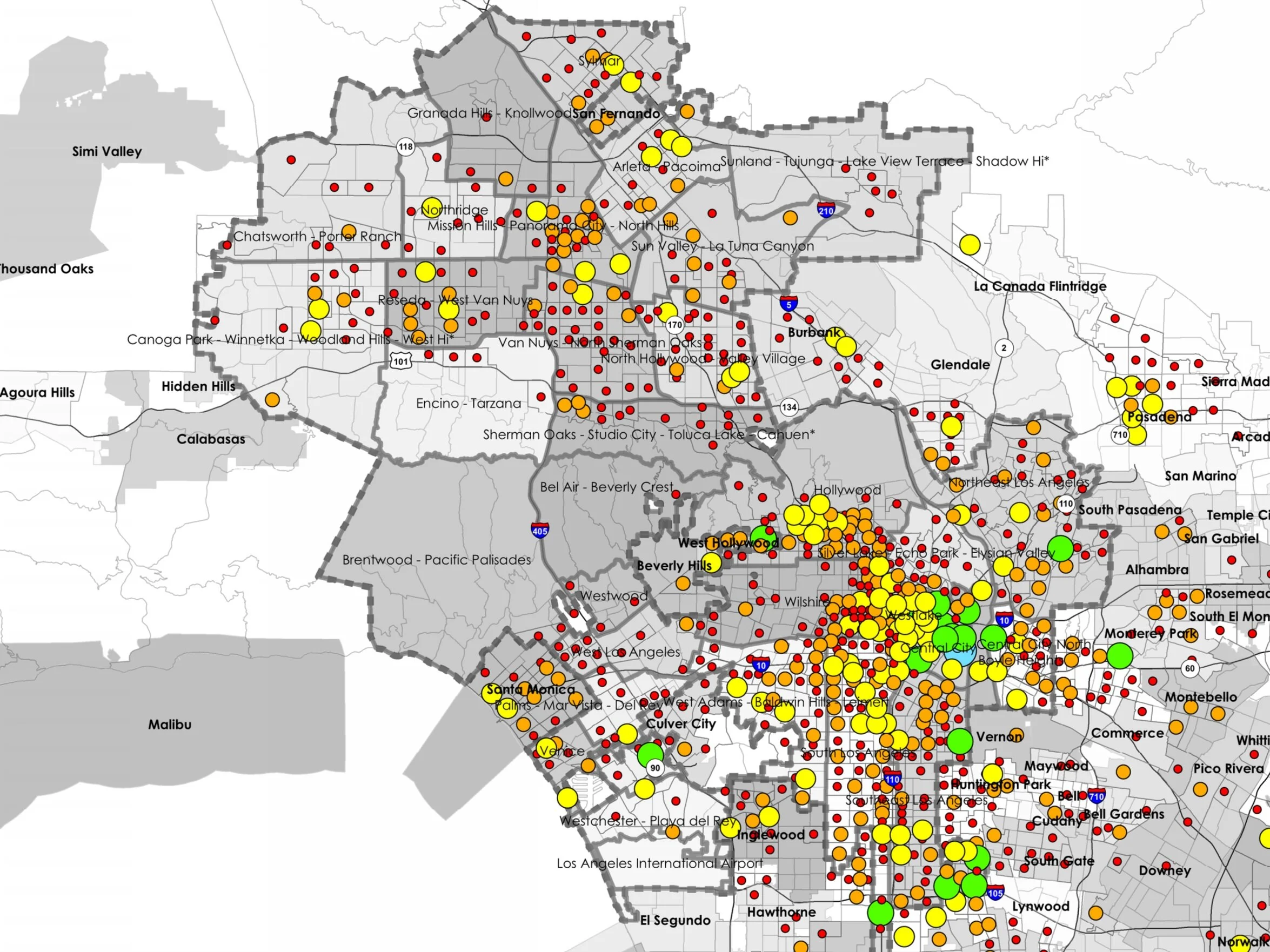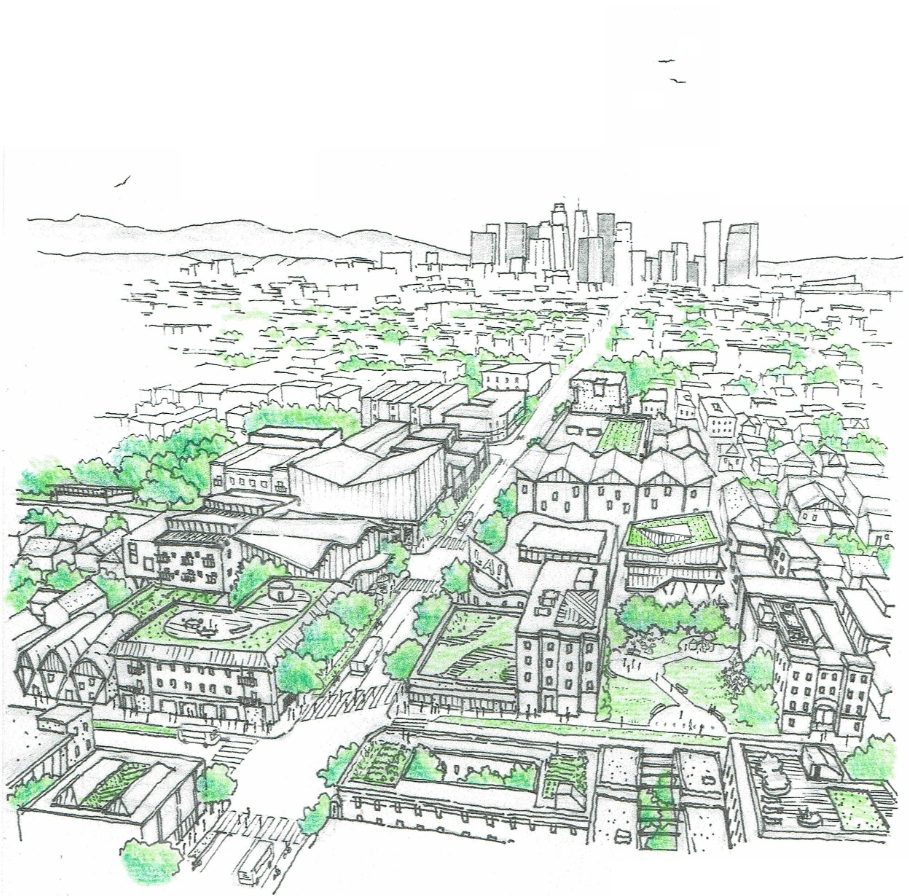The data presented in the Center’s research and publications are sourced from several publicly available datasets and supplemented by interviews and public comments where appropriate. This publication is a compilation of publications and presentations recently conducted by the Center for the purposes of advancing the five main objectives, as well as citations for the datasets used.
Read MoreThe Center for Pacific Urbanism has inventoried potentially suitable sites for homeless off street sanctuary using GIS and other planning support tools, sorted by feasibility according to developing criteria. This report publishes the most recent suitable sites analysis for homeless sanctuary ranked by a composite score that takes into account size (site area), density of unsheltered individuals, road access, topographic slope, proximity to fire hydrants and sewer, market rate of land, ecology, and land use compatibility.
Read MoreToday, housing production in Los Angeles overall is eight times less than what it ought to be in order to bridge the housing shortage. Affordable housing production is less than a twentieth of the necessary supply rate to make up for over half a century of inequitable housing policies. While fiscal resources are being expended and depleted at unsustainable rates, the cost of housing continues to rise and the number of households falling into homelessness continues to increase
Read MoreIn order to meet housing targets set by the Southern California Association of Governments (SCAG), Pacific Urbanism proposes a comprehensive, holistic approach to land use and zoning designations amongst Community Plan Areas (CPAs) in Los Angeles.
Read MoreTransit-oriented communities (TOCs) are a land use policy adopted by the City of Los Angeles which anticipate higher production of housing within specified boundaries. Advocates for TOC claim this strategy is a viable solution to the meet the City's housing needs. However, housing production from TOC is far below the total units needed in the City.
Read MoreThe Mello Act sets requirements for the demolition, conversion and construction of housing in the Coastal Zone and applies to the Coastal Zone throughout the entire state of California. The primary objective of this paper is to evaluate what the impacts of changes to the Mello Act would be within the Coastal Zone in the City of Los Angeles.
Read MoreSubsidized low income housing units, often referred to as “affordable housing”, are housing units in which rental costs are partially or wholly subsidized by public funds and agencies. These units are intended to provide support for households who are overburdened by rent but also service senior citizens, individuals with severe mental health conditions, people with physical disabilities, and others who require similar assistance. As such, knowing the total amount and location of these units is imperative to understanding the current status of affordable housing in Los Angeles, as well as the creation of future policy surrounding affordable housing and overall dwelling unit production citywide.
Read MoreAs Los Angeles continues to face a worsening housing scarcity and unaffordability crisis, we must determine and implement policies that will help our neighbors avoid homelessness by providing adequate shelter and housing both in the immediate as well as permanently. This study provides a comprehensive list of potential sites for off-street homeless shelters in Los Angeles as well as an inventory of precedents from various cities that should be considered by local policymakers in addressing homelessness in our communities.
Read MoreEvery eight years, a housing production target is determined for the City of Los Angeles by the Southern California Association of Governments (SCAG) in their Regional Housing Needs Assessment (RHNA). For the upcoming 2021-2029 cycle, Pacific Urbanism has further determined the production targets for each of the City's thirty-five Community Plan Areas through the FAIR Plan housing allocation index.
Read MoreLand use and zoning policies are restricting the construction of dwelling units in the City of Los Angeles. As a result, housing production in Los Angeles has failed to provide sufficient dwelling units to accommodate the city’s population growth. Certain areas of the city have even experienced a net loss of dwelling units, further exacerbating the problem.
Read MoreNeighborhood communities and the Councils that represent these are in a position to address the housing shortage, which is the principal driver of housing unaffordability in the LA region. While some may perceive housing unaffordability to be an issue that predominantly affects lower-income households, in fact, the lack of competitively priced housing and the root causes that drive this condition have profoundly adverse effects on the regional economy, the environment, and social equity in various ways. The following study builds onto a body of academic and policy research into the root causes of the region’s infated housing prices and the most viable solutions, ranked from low hanging fruit to the long range planning efforts that are required. A different and perhaps better Los Angeles is possible: one that provides housing options that are accessible to all segments of society, that contributes to regenerative natural ecosystems, and that fosters economic development, innovation, and contributes to increasing wages. As the saying goes, “it is going to take all of us,” to build a Los Angeles that meets the broader needs of all communities.
Read More









